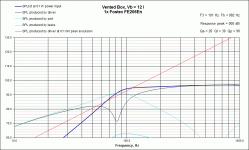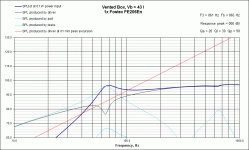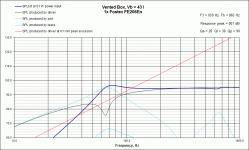hey now.
just wondering what you guys think of them? common sense audio (audio nirvana) sells those and says they are the best of the fostex drivers.
id be putting it in a smaller bass reflex (no bigger than 1.5 cuft, sorry its the wifes orders- she flipped when she saw my 5.6 speakers i built).
just wondering how they sound overall. im not looking for specifics, thats kind of impossible. i just wonder how they sound and if they are a good buy for $200 for a pair, or if i am better off going back to audio nirvana super 8s or super 6's
just wondering what you guys think of them? common sense audio (audio nirvana) sells those and says they are the best of the fostex drivers.
id be putting it in a smaller bass reflex (no bigger than 1.5 cuft, sorry its the wifes orders- she flipped when she saw my 5.6 speakers i built).
just wondering how they sound overall. im not looking for specifics, thats kind of impossible. i just wonder how they sound and if they are a good buy for $200 for a pair, or if i am better off going back to audio nirvana super 8s or super 6's
Just did some modeling of a BR for these. Good to about 110 Hz, they really want to be in a horn.
There are quite a few Fostex i personally prefer to the FE206.
dave
There are quite a few Fostex i personally prefer to the FE206.
dave
For wideband drivers, the smaller, the better. You give up bass (just use a sub) but everything else is magical in comparison, e.g. treble, dispersion, imaging. I like the 4" FE103En's ($100/pair) with a sub much, much better. They don't do rock so well unless you high-pass them.
The exception is if you need the FE206En's better efficiency for a 2-watt tube amp, have a good-sized room, you want performance down to 40Hz with no sub, and you're willing to build a big horn or BLH for it. Then it can be pretty good (treble and dispersion will still not be great though.)
But in a bass reflex, the FE206En it will be perfectly awful unless you EQ the hell out of it (losing the efficiency advantage) and use stereo subs, in which case, it could be serviceable.
The exception is if you need the FE206En's better efficiency for a 2-watt tube amp, have a good-sized room, you want performance down to 40Hz with no sub, and you're willing to build a big horn or BLH for it. Then it can be pretty good (treble and dispersion will still not be great though.)
But in a bass reflex, the FE206En it will be perfectly awful unless you EQ the hell out of it (losing the efficiency advantage) and use stereo subs, in which case, it could be serviceable.
No highs no lows might as well be Bose... Just joking. An old friend built a pair, with the horn cabinets and to me they sound small. But then I have a pair of Snell type A's.
For wideband drivers, the smaller, the better. You give up bass (just use a sub) but everything else is magical in comparison, e.g. treble, dispersion, imaging. I like the 4" FE103En's ($100/pair) with a sub much, much better. They don't do rock so well unless you high-pass them.
where do you recommend i high pass them at? i can use them in a bass reflex right? im also looking at the 165 and 225wk as well
Last edited:
No highs no lows might as well be Bose... Just joking. An old friend built a pair, with the horn cabinets and to me they sound small. But then I have a pair of Snell type A's.
hahaha i love that saying.
thanks for all your help guys btw.
where do you recommend i high pass them at? i can use them in a bass reflex right? im also looking at the 165 and 225wk as well
Not if you high-pass them you can't. Well, you can if active, but it would be rather pointless.
The 206 doesn't really have specs. all that well suited for a BR whatever CSA might claim, since they conform to the laws of physics. This will depend on what the output impedance of the amplifier driving them is like though, or whether you're willing to use some Eq. Assuming a 'pure' voltage source & the Factory spec., 12 litres tuned to 82Hz will give a nicely damped alignment which typical room gain should pull ~flat. Absolutely no real LF output < ~80Hz of course, but the 206 was primarily designed to be used with high output impedance amplifiers & back horns of various types. This comes direct from the man who designed the FExx6E series units BTW.
Some FR plots. These do not take room-gain into account, but for the sake of interest:
12 litres, 82Hz, voltage source
1.5ft^3, 61Hz (approx. what I've often seen used in CSA boxes), voltage source
Same 1.5ft^3 box & tuning, but with a high output impedance amplifier (4ohms, typical for many current commercial SET amps).
All boxes assumed to be lined with damping material.
YMMV as ever of course.
Attachments
Last edited:
where do you recommend i high pass them at? i can use them in a bass reflex right? im also looking at the 165 and 225wk as well
Try 80Hz (that's their Fs and the frequency that the factory 6-liter BR is tuned to.)
Sorry, I didn't mean to say rule out all 6" drivers -- I just wouldn't use the FE206En in a smallish bass reflex. (Although personally, I would only use a 6" widebander "full range" when there's no sub.) A few 4" can be used with no sub, which seems to be a real sweet spot for a lot of folks.
Sorry, I didn't mean to say rule out all 6" drivers -- I just wouldn't use the FE206En in a smallish bass reflex. (Although personally, I would only use a 6" widebander "full range" when there's no sub.) A few 4" can be used with no sub, which seems to be a real sweet spot for a lot of folks.
oh its no big deal. see the problem im having is not so much the size of the driver, its being able to weed through some of the engineering stuff that i have no clue about. im a woodworker so i focus on the building side more than the designing side. i also have no issue using a subwoofer.
what im so frustrated about are things like:
-a full range driver that i can go from classical to hardcore or industrial or death metal without destroying the driver.
-do i want to look for a driver with a phase plug, without a phase plug? does it really even matter?
-do i want a whizzer cone? why do some people say a whizzer cone is so important when other manufacturers brag that their driver doesnt need a whizzer cone or phase plug
-finding a fullrange woofer i can crossover low enough to keep the bass non directional. (in my space its stupid to have 2 small enclosures to keep the wife happy but then have 2 subs right next to the small boxes. takes up same amount of room as if i just built big floor standing to begin with)
-a fullrange driver in a small br box (by small i mean 1.5 cuft give or take, maybe a bit more)
i loved my audio nirvana's. i had them in various enclosures from 1.5 to 5.6, even had the ambiance. they got a little beamy at certain high notes but it is what it is. i dont want to go bigger than an 8" and kinda wanna stay in the 5"-6" for box size.
lol so getting info to cross a woofer off the list is a sigh of relief for me.
edit: why do people say smaller drivers are better than bigger? when broken in the audio nirvana 15's sound amazing. even my super 10's had great highs
Last edited:
osd1 - I guess the folks who wax rhapsodic about smaller displacement wide-banders have lived with a wide range of other system types, sometimes over listening careers of 40+yrs, and have come to admire the things they do so well - speed, intimacy, resolution of low-level/inner detail, to name but a few. Hell, I've even known folks to modify their habits over decades - "pounding less, enjoying it more"
When assisted with powered woofers and high-passed, something like a Alpair7.3, Fostex FF85WK, several models of TangBand, Parts Express Dayton house brand, etc, ad nauseum, can work for a wide range of musical tastes and listening levels, but none is guaranteed to satisfy for all .
FWIW, a driver that gets some very good press from users, including Bob Brines, is the TB W8-1772 - not dissimilar in many respects to the AN family, but at over $200 ea, if price is a major part of the calculus, probably can't be considered a budget driver.
When assisted with powered woofers and high-passed, something like a Alpair7.3, Fostex FF85WK, several models of TangBand, Parts Express Dayton house brand, etc, ad nauseum, can work for a wide range of musical tastes and listening levels, but none is guaranteed to satisfy for all .
FWIW, a driver that gets some very good press from users, including Bob Brines, is the TB W8-1772 - not dissimilar in many respects to the AN family, but at over $200 ea, if price is a major part of the calculus, probably can't be considered a budget driver.
-a full range driver that i can go from classical to hardcore or industrial or death metal without destroying the driver.
Pretty much any widebander can do that, if and only if there's a crossover to a woofer around 200Hz. And this is an -awesome- way to go.
-do i want to look for a driver with a phase plug, without a phase plug? does it really even matter?
There are drivers which don't need one, which sound great. Sometimes a phase plug can improve a driver after the fact but I'd say it's not a basis for choosing a driver.
-do i want a whizzer cone? why do some people say a whizzer cone is so important when other manufacturers brag that their driver doesnt need a whizzer cone or phase plug
Oh hell no, you don't want a whizzer. If you are locked into a big driver, it adds a ragged amount of high frequencies so in that case, it's an improvement.
-finding a fullrange woofer i can crossover low enough to keep the bass non directional. (in my space its stupid to have 2 small enclosures to keep the wife happy but then have 2 subs right next to the small boxes. takes up same amount of room as if i just built big floor standing to begin with)
Exactly. Speakers like to be big. What often happens in the widebander world is you fall in love with a beautiful driver that fits into a small package. And then a few months later, here come the sub(s). So if you go with woofers, you'll most likely need two of them.
-a fullrange driver in a small br box (by small i mean 1.5 cuft give or take, maybe a bit more)
If you can go to that volume, I'd recommend a MTLT (which is just a BR stretched to be tall and skinny, but these designs need computer simulation -- you will find tons of proven designs though.)
edit: why do people say smaller drivers are better than bigger? when broken in the audio nirvana 15's sound amazing. even my super 10's had great highs
A small driver, if you choose a nice one, will have comparatively smoother midrange treble (compared to an 8" which often has a spiky, peaky, ragged response, esp. with a whizzer) and the smaller cone size usually means better dispersion (it will beam, but that beaming behavior will start at a much higher frequency).
Having said that, there is a caveat. If you hear one of the world's finest 8" drivers, they will amaze and astonish (e.g., Lowther field coils, Feastrex D9NF etc.). But if I put my (pricey) 8" AER Mk-II's (~$2k, I think) next to the FE103En's ($100), there are many reasons to prefer the sound of the smaller, cheaper drivers.
rj - I'm firmly in support of your recommendation of MLTL (I've built many and am currently listening to A7s in a pair) but would suggest you revisit the sentence "(which is just a BR stretched to be tall and skinny,..) ", they're actually rather more than that, and yes designing them involves understanding modeling software, and engineering for specific goals/compromises - otherwise any DIY hack could do it 😉
Hi Chrisb,
I welcome the correction! What more are they?
Let's leave it to those with more expertise than my own for the full technical explanation, but simply put - MLTLs rely on quarter wavelength standing waves rather than just helmholtz resonance behaviour to generate lowest frequencies. Whereas with sealed enclosures, aspect ratios of dimensions have less critical effects, once an enclosure is vented to any degree, those ratios and any degree of taper, as well as driver location, damping etc, can make world of difference.
It's probably not out of place to say that while designs operating on such principles have been around for decades, the art/science of using combination of drivers' TS parameters and computer worksheets widely available to avid builders to model and refine such enclosure designs is relatively new.
There, I've exhausted my understanding of the subject, time for the intellectual heavyweights to contribute.
do you mean "EN"? -- with its loading and relatively high tuning, FE206EN works well in a Karlson 12- deep drums sound very good - its better in that application with regards to dynamic cone behavior than a 1772. 206EN has an on-axis spike around 2K6
FE206EN vs AN8 stamped frame in a "Druid" sized pipe
206 in a 1954 Karlson 12
FE206EN vs AN8 stamped frame in a "Druid" sized pipe
An externally hosted image should be here but it was not working when we last tested it.
206 in a 1954 Karlson 12
An externally hosted image should be here but it was not working when we last tested it.
Last edited:
so a tall skinny mltl might be the way to go.
my main goal is give or take 37hz-15k. everything else in any recording i listen to is just noise.
my main goal is give or take 37hz-15k. everything else in any recording i listen to is just noise.
Re the query above, a bass reflex box assumes 'pure' Helmholtz (cavity) resonance, i.e. a uniform air-particle density within the enclosure and no standing waves. An MLTL deliberately generates and uses standing waves. The transition point between the two can be said to occur when one dimension is stretched sufficiently for the Eigen modes to change the cabinet behaviour away from what stock Helmholtz maths states it should be for a given Vb and vent dimensions.
Reading all of the above said, coupled with my experience with Fostex Fe206 e in ML TL and all other speakers that I've tried, I believe that in this case the best solution is a sort of a FAST: 8" woofer (suitable wideranger) in ML TL + a 3" or eventually 4" fullranger of chioce in a small sealed box sitting on top of ML TL one. 300-400 hz 1st order crossover and voila! You can have the best of both worlds + a happy wife 🙂 just my 2 c. Vix
- Status
- Not open for further replies.
- Home
- Loudspeakers
- Full Range
- general thoughts on fostex fe206n


